Blog
Cerebus re-read 2015–2016: Church & State II
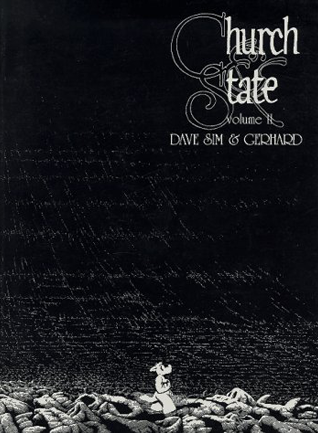 It’s tempting to review Church & State I & II as one work, which it technically is, but there’s definitely enough in this volume to warrant its own post. Aside from Dave and Ger really starting to combine forces in a breathtakingly impressive fashion, Dave’s writing is a total home run. He totally nails the dramatic structure in this second half of the story, but very fluidly. It’s become clear how valuable it is for Dave to have planned out so much of the book before writing it—so much thought has gone into it by this point that there’s nary a wasted line of dialogue or superfluous drawing. It’s all reaching toward a singular purpose with maximum efficiency and STILL manages to be staggeringly entertaining. I had to have a little chuckle to myself as I cracked open this volume…Dave normally writes a full-page foreword, and he noted in the foreword of volume I that readers following along only in the phonebooks would have to be patient for two years for this one. So, as Dave says in the very short volume II foreword, “Hey, don’t let me stop you.”
It’s tempting to review Church & State I & II as one work, which it technically is, but there’s definitely enough in this volume to warrant its own post. Aside from Dave and Ger really starting to combine forces in a breathtakingly impressive fashion, Dave’s writing is a total home run. He totally nails the dramatic structure in this second half of the story, but very fluidly. It’s become clear how valuable it is for Dave to have planned out so much of the book before writing it—so much thought has gone into it by this point that there’s nary a wasted line of dialogue or superfluous drawing. It’s all reaching toward a singular purpose with maximum efficiency and STILL manages to be staggeringly entertaining. I had to have a little chuckle to myself as I cracked open this volume…Dave normally writes a full-page foreword, and he noted in the foreword of volume I that readers following along only in the phonebooks would have to be patient for two years for this one. So, as Dave says in the very short volume II foreword, “Hey, don’t let me stop you.”
After Cerebus is hurled into lower Iest by his usurper, The Giant Stone Thrunk (aka Necross the haha Mad), he’s confronted by the Roach (now a parody of black-costume Secret Wars Spider-Man), who reveals that he’s preparing for the Secret Sacred Wars, which amounts to trying to dethrone Thrunk (“Epop”). Cerebus then gets transported without warning by the Big Round Glowing White Strange Thing, first to another dimension where he’s told about “The Final Ascension,” then to Countess Michele’s much smaller house in the lower city. She details her history with Weisshaupt, and reveals that Weisshaupt had chosen Cerebus to take his place as Tarim on earth in the event of Weisshaupt’s death. Michele gives him a packet, which contains a message from Weisshaupt: a picture of one of the cannons that Weisshaupt had set up across from Cerebus’ hotel when he tried to take all the gold Cerebus had amassed last volume. Cerebus gets the message and sets off back up the Black Tower to the upper city to get back his papacy (but not before running into a hilarious parody of Mick Jagger and Keith Richards). The Roach begins climbing the tower in order to confront Thrunk, and Cerebus follows. Astoria had been waiting at the top for the Roach, who pushes her aside in his determination to kill the false pope. Cerebus follows shortly after, yelling at Astoria to GO AWAY when she tries to stop him. She inexplicably dissolves into thin air at this command. The Roach is kicked back into the lower city by Thrunk, but Cerebus is able to utilize the cannons and the last moment (and one of the best sequences of the entire series) and kills Thrunk.
Cerebus returns to his hotel and is immobilized by the Big Round Glowing White Strange Thing, which returns him to the previously-seen dimension. There he speaks to Suenteus Po, who outlines his previous lives’ failed attempts to take part in The Final Ascension (it turns out you need to hold a sphere of purest gold on TOP of the Black Tower. Not next to it, inside it, or across the river from it). Cerebus is released from the dimension to find that the Lion of Serrea (the pope of the Western Church) has been assassinated, and that Cerebus needs to sentence the perpetrator, who is revealed to be Astoria. Cerebus commands Bishop Powers to find someone to make a gold sphere for him, and leaves to question Astoria, who’s chained in a prison cell. She freely admits to the assassination, and asserts that Cerebus owes her for his current position, having helped him rise to power in High Society. Cerebus balks at this, so Astoria tries another tactic. She offers to have sex with him if he grants her a favor afterward, but then teasingly rescinds the offer, reminding him that as an orthodox Tarimite, he can’t have sex out of wedlock. Cerebus gags Astoria, declares the two married, rapes her, and falls asleep. When he wakes, he ungags Astoria and she speaks to him about The Final Ascension, asking what he would say to Tarim (or, “Terim,” as she says—the female version of the deity), making it clear that Cerebus is not worthy, and that a woman will be the one to successfully ascend. She then outlines for him all of the ways that her fate could play out, the most important of which is that if he sentences her to death, Cirin will descend on Iest with her troops and kill Cerebus, having reserved the pleasure of killing Astoria for herself. It’s decided that the best option is for Cerebus to break Astoria out and then allow himself to be knocked out. He would then absolve himself of any responsibility to either the church or Cirin. However, before Cerebus can break her chains, Powers returns to inform him that the gold sphere had some imperfections and is being recast, and to take him to the throne room to prepare for the trial.
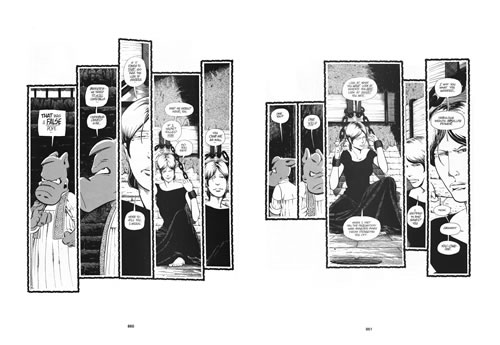
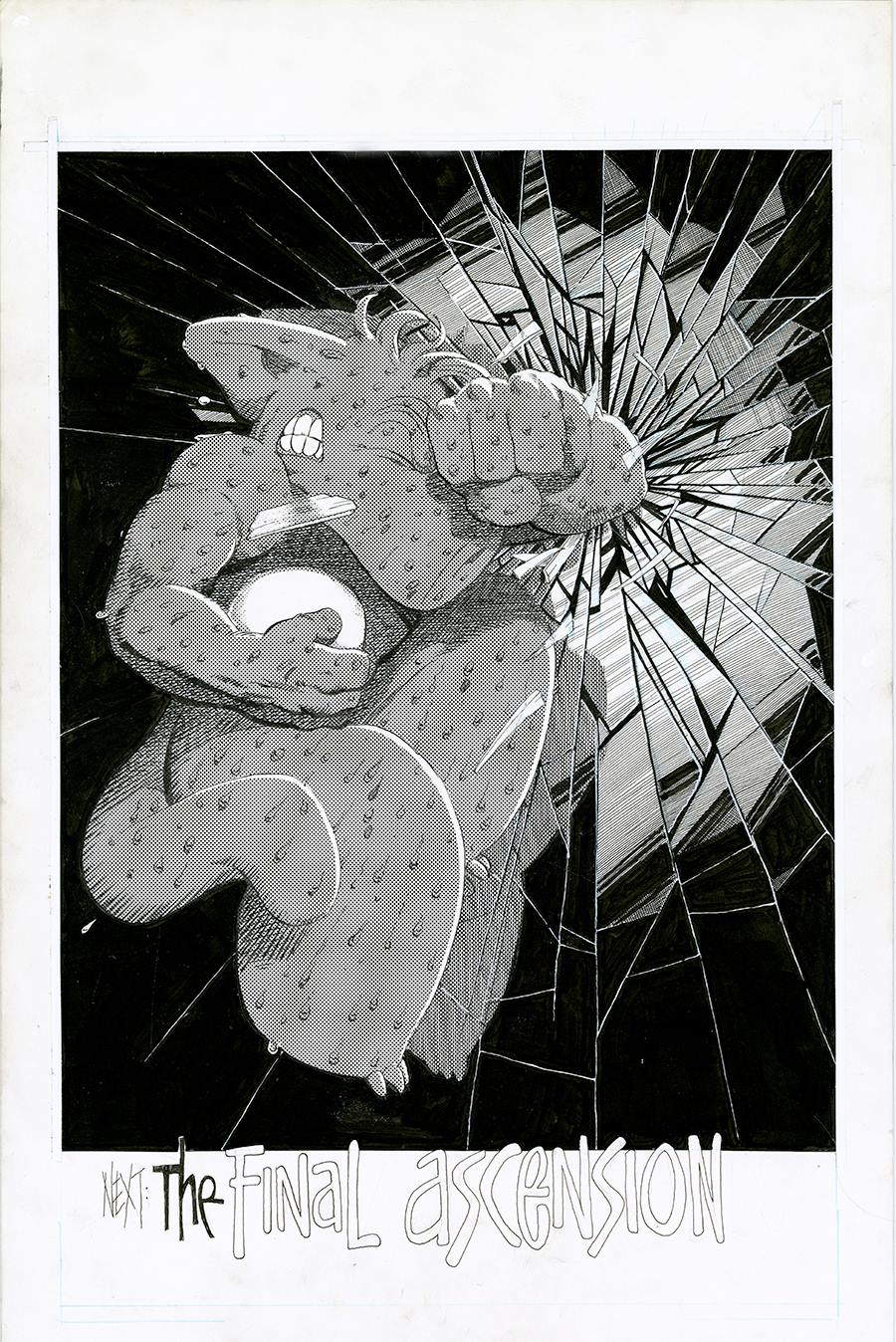 Astoria reveals at the trial that when she dissolved after Cerebus told her to GO AWAY, she reappeared in front of the Lion of Serrea, seemingly mid-argument. She killed him with a nearby knife, as though she were compelled to do so. After some bang-up dialogue and illusions that may be sorcery, Cerebus washes his hands of the matter. Meanwhile, Cirin gets news of the trial and orders her troops to mobilize for the invasion of Iest. When we finally see her face, it’s revealed that she is one of the two other aardvarks in Estarcion that Weisshaupt mentioned. Cerebus finds a box at the foot of his throne’s platform, seemingly just having appeared from nowhere. He opens it to find a gold sphere and a note: “Good luck. –W.” He grabs the sphere and bolts for one of the windows, jumping through it to the interior wall of the vertically growing Black Tower outside. The excess tower detaches from its base and heads toward the moon faster than sound, Cerebus hanging on for dear life. When he’s deposited on the moon he’s met by a man in judge’s robes, who calls himself “The Judge,” who claims to see all and to know all. He tells Cerebus that he will NOT conquer the known world, though he came close. He also lets it be known that the moon is NOT heaven, and that he is NOT Tarim. He then goes on to detail the origin of the universe.
Astoria reveals at the trial that when she dissolved after Cerebus told her to GO AWAY, she reappeared in front of the Lion of Serrea, seemingly mid-argument. She killed him with a nearby knife, as though she were compelled to do so. After some bang-up dialogue and illusions that may be sorcery, Cerebus washes his hands of the matter. Meanwhile, Cirin gets news of the trial and orders her troops to mobilize for the invasion of Iest. When we finally see her face, it’s revealed that she is one of the two other aardvarks in Estarcion that Weisshaupt mentioned. Cerebus finds a box at the foot of his throne’s platform, seemingly just having appeared from nowhere. He opens it to find a gold sphere and a note: “Good luck. –W.” He grabs the sphere and bolts for one of the windows, jumping through it to the interior wall of the vertically growing Black Tower outside. The excess tower detaches from its base and heads toward the moon faster than sound, Cerebus hanging on for dear life. When he’s deposited on the moon he’s met by a man in judge’s robes, who calls himself “The Judge,” who claims to see all and to know all. He tells Cerebus that he will NOT conquer the known world, though he came close. He also lets it be known that the moon is NOT heaven, and that he is NOT Tarim. He then goes on to detail the origin of the universe.
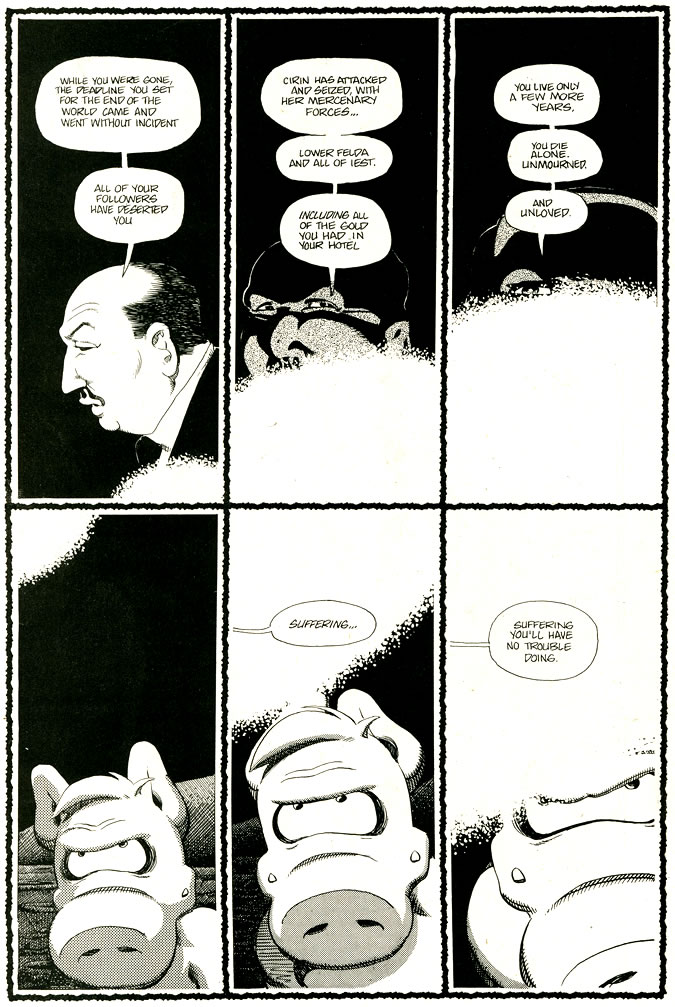 In the beginning there was the void, and the void was Tarim. Suddenly, Terim appeared as a pinpoint of light. Tarim, in his curiosity, exerted extensive “pressure” on the light in an attempt to know it better, to see what it was like inside, which caused Terim to split in two, explode, and die. Stars, planets and other celestial bodies are revealed to be the remains of Terim’s corpse, and Tarim just sits around, lonely, and hosts the dead parts of the only other being to exist in his vicinity. The Judge then looks to the future, where he outlines an unnamed culture’s attempts to hold the earth hostage by threatening to explode the sun. They do so, and aside from some blue-green fungus down the line, that’s it for life in this solar system. Cerebus learns that in his absence, Cirin has taken over Iest. The Judge reveals that Cerebus will live only a few more years, and will die alone, unmourned and unloved. He asserts that if Cerebus ever considers his suffering unjustified, that he should just recall his second marriage (a reference to his raping of Astoria). He then returns Cerebus to his hotel on the side of the Black Tower, which has been ransacked by Cirinist troops. His gold taken and followers dispersed, Cerebus attempts suicide by leaping down the tower, but chickens out. He begins walking down the tower toward the lower city.
In the beginning there was the void, and the void was Tarim. Suddenly, Terim appeared as a pinpoint of light. Tarim, in his curiosity, exerted extensive “pressure” on the light in an attempt to know it better, to see what it was like inside, which caused Terim to split in two, explode, and die. Stars, planets and other celestial bodies are revealed to be the remains of Terim’s corpse, and Tarim just sits around, lonely, and hosts the dead parts of the only other being to exist in his vicinity. The Judge then looks to the future, where he outlines an unnamed culture’s attempts to hold the earth hostage by threatening to explode the sun. They do so, and aside from some blue-green fungus down the line, that’s it for life in this solar system. Cerebus learns that in his absence, Cirin has taken over Iest. The Judge reveals that Cerebus will live only a few more years, and will die alone, unmourned and unloved. He asserts that if Cerebus ever considers his suffering unjustified, that he should just recall his second marriage (a reference to his raping of Astoria). He then returns Cerebus to his hotel on the side of the Black Tower, which has been ransacked by Cirinist troops. His gold taken and followers dispersed, Cerebus attempts suicide by leaping down the tower, but chickens out. He begins walking down the tower toward the lower city.
No bones about it, this book is a serious masterpiece, especially when combined with Volume I. I mentioned before that Dave’s writing is masterful by this point. The four or so issues that comprise Astoria’s trial contain some of the tensest moments in fiction, and some of the most natural dialogue in comics. It’s paced incredibly effectively and facilitates some great edge-of-your-seat reading, even on my fourth run-through. The paneling in this volume is also quite interesting. During Cerebus and Astoria’s confrontation in the prison cell and for some of the trial, Dave utilizes a ton of white space, which surrounds a number of very thin panels in the center of the page. This adds a feeling of claustrophobia, tension, and helps to create a certain amount of urgency in the dialogue. It’s pretty ingenious in design really, and shows an immense command of storytelling. By allowing the reader to read from left to right, rather than having to read a top row of panels and then direct the eye back to the left for the bottom row of panels, Dave creates a real sense of momentum, which, when integrated with the subject matter, is damned compelling.
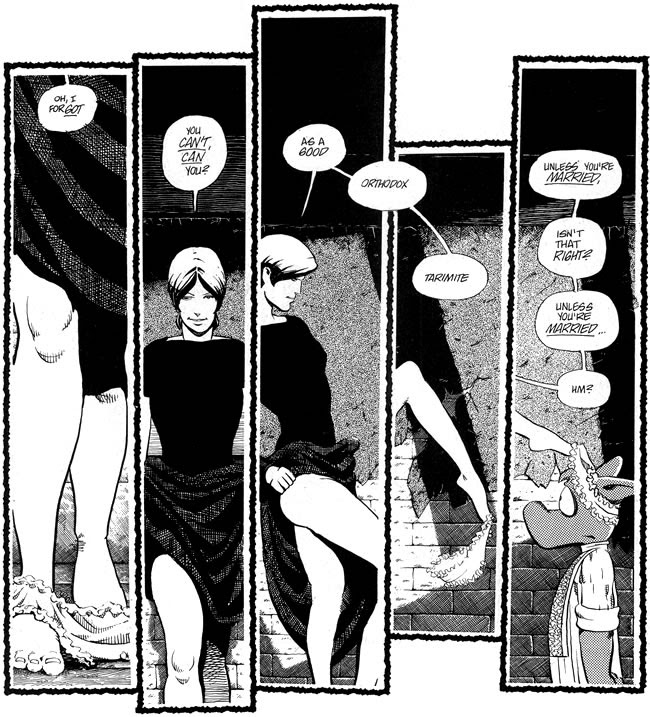
We begin to see in this volume what is later termed Cerebus’ “magnifier effect.” In moments of great energy, tension, or consequence, it seems that Cerebus can unwittingly be a catalyst for some monumental events, such as causing Astoria to disappear or causing the Black Tower to grow as he gets closer to obtaining a gold sphere (though this may just be related to the Ascension itself, rather than to Cerebus specifically). This will come to play a large role in Mothers & Daughters, but it also explains his ability to command an enormous group of people without having much charisma on his side.
Gerhard, too, does some very impressive work here. His depiction of the moon alone is worthy of an Eisner. On top of that, the incredible textures he’s able to squeeze out of stone, fabric, and glass show a remarkable understanding of light and shadow, perspective, and tone. In an extremely short time, he’s corrected any lingering obstacles to making his and Dave’s work look integrated. It’s so refined by this point that you might be surprised to read that it only improves from here. I can’t imagine how much work it would have taken to draw the faces of the Black Tower so many times, but Ger is an incredible artist, and none of it looks phoned-in or glossed over. He gave 100% to every page, so it’s not hard to see how he wound up with chronic stomach pains near the end of the series. He’s better now, and we’re better for his contributions to the world of not just comics, but art itself. Gerhard’s task would be a bit less intensive over the next 12 issues, as we spend the entire following storyline in one small plot of land on the side of the Black Tower in Jaka’s Story.
Top Moments
Cerebus’ dustpan lesson
“We’re all plants…Cerebus can feel it…”
Page 750. Just read the book.
Talking about Heaven with Po
Cerebus: “Will Cerebus still be able to drink?”
Po: “I don’t know. I guess so. It’s hard to tell. Probably you’d be able to drink but you wouldn’t want to.”
Cerebus: “Why?”
Po: “Well, because everything will be perfect and you’ll feel good without drinking…”
Cerebus: “Cerebus doesn’t drink to feel good…Cerebus drinks because he likes drinking…”
Po: “I’m not really the one to ask. I don’t know. Maybe you’ll be able to drink but you won’t get hangovers.”
Cerebus: “That sounds more like it.”
Fred lip-synching with the artist chap
For those who want to read along, the entire series is available as a digital download at Cerebus Downloads.
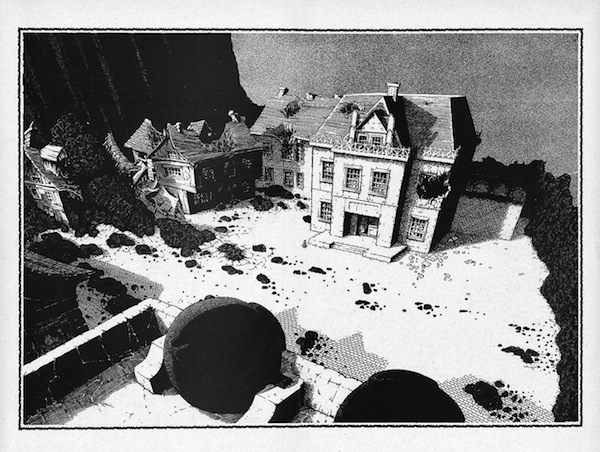

Recent Comments